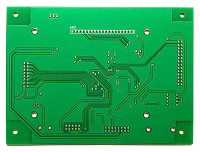1. Precipitation of etching solution in printed circuit
Reason
(1) The ammonia content is too low.
(2) Water dilution excess.
(3) The specific gravity of the solution is too large.
Solution
(1) Adjust the pH value to reach the process specified value or appropriately reduce the air extraction volume.
(2) The adjustment shall be carried out in strict accordance with the provisions of process requirements or appropriately reduce the air extraction volume.
(3) Discharge part of the solution with high specific gravity according to the process requirements. After analysis, add the aqueous solution of ammonium chloride and ammonia to adjust the specific gravity of the etching solution to the allowable range of the process.
2. The metal corrosion resistant coating in the printed circuit is etched.
Reason
(1) The pH value of etching solution is too low.
(2) High chloride ion content.
Solution
(1) Adjust to the appropriate pH value according to the process regulations.
(2) Adjust the chloride ion concentration to the process specified value.
3. The copper surface in the printed circuit is blackened and cannot be etched.
Reason
(1) The content of sodium chloride in the etching solution is too low.
Solution
(1) Adjust sodium chloride to the specified value according to the process requirements
4. There is residual copper on the substrate surface in the printed circuit
Reason
(1) Insufficient etching time.
(2) Unclean film removal or corrosion resistant metal.
Solution
(1) Conduct the first article test according to the process requirements to determine the etching time (i.e. adjust the transmission speed).
(2) Before etching, the plate surface shall be inspected according to the process requirements, and there shall be no residual film and anti-corrosion metal infiltration plating.
5. The etching effect on both sides of the substrate in the printed circuit is significantly different.
Reason
(1) Nozzle of equipment etching section is blocked
(2) The conveying rollers in the equipment shall be staggered in front of and behind each rod, otherwise there will be traces on the plate surface
(3) The spray pressure drops due to water leakage of the spray pipe (often at the joints between the spray pipe and the manifold)
(4) The motor idled due to insufficient solution in the preparation tank
Solution
(1) Check the nozzle blockage and clean it accordingly.
(2) Re thoroughly check and arrange the staggered position of rollers in each section of the equipment.
(3) Check all joints of the pipeline and repair and maintain them.
(4) Frequently observe and timely supplement to the position specified in the process.
6. The uneven etching of the board surface in the printed circuit leaves residual copper in some parts.
Reason
(1) The film removal on the substrate surface is not complete, and there is residual film
(2) The thickness of copper plating layer on the plate surface is uneven during copper plating on the whole plate
(3) When the board surface is corrected or repaired with ink, it sticks to the driving roller of the etching machine
Solution
(1) The film removal on the substrate surface is not complete, and there is residual film.
(2) The thickness of copper plating layer on the plate surface is uneven during copper plating on the whole plate.
(3) When the board surface is corrected or repaired with ink, it sticks to the driving roller of the etching machine.
(4) Check the film stripping process conditions, adjust and improve them.
(5) Brush grinding and flattening process can be used to ensure the consistency of copper layer thickness according to the density of circuit graphics and wire accuracy.
(6) The repaired ink must be cured, and the contaminated rollers must be checked and cleaned.
7. Serious side corrosion of conductor was found after etching in printed circuit board.
Reason
(1) The nozzle angle is wrong and the nozzle is out of alignment
(2) Excessive spray pressure leads to rebound and serious side corrosion
Solution
(1) Adjust the nozzle angle and nozzle according to the instructions to meet the technical requirements.
(2) According to the process requirements, the spray pressure is usually set at 20-30psig and adjusted by process test method







 Nov. 09, 2021
Nov. 09, 2021 





